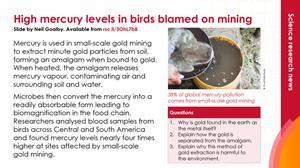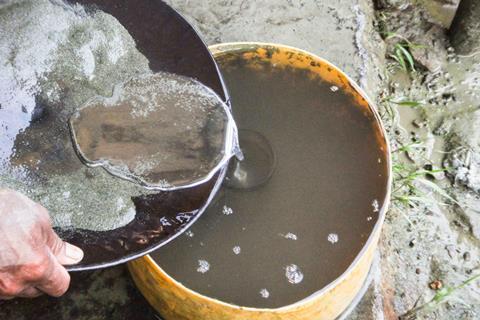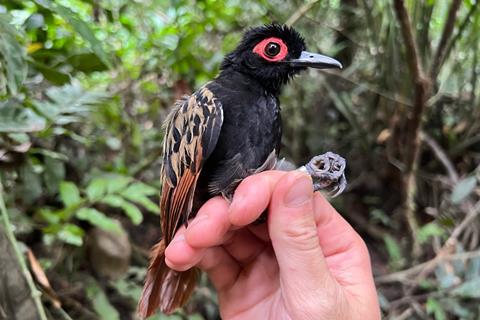Small-scale mining accounts for high percentage of mercury pollution
-

Download this
Use this story and the accompanying summary slide for a real-world context when studying native metals with your 14–16 learners.
Download the story as MS Word or PDF and the summary slide as MS PowerPoint or PDF.
Artisanal and small-scale gold mining has led to high levels of mercury in tropical birds. The birds and the organisms linked to them in the food chain are at risk of harm from exposure to this neurotoxin, as shown by an analysis of 13 years’ worth of data by an international research team, led by Christopher J. Sayers II at the University of California.

Gold is an unreactive metal used in a wide variety of products including jewellery, dental fillings and smartphones. In nature, gold typically exists in its native state as nuggets and grains in rocks and sediments. Each year, about 3000 tonnes of native gold is mined, with some 15% of this metal dug up by artisanal and small-scale miners. These miners often use mercury to extract specks of gold from crushed rock and sediment.
The mercury binds to the gold specks to form an amalgam. Heating this amalgam causes the mercury to vaporise, leaving the pure gold behind. The mercury vapour pollutes not only the air but also surrounding soil and water, where bacteria and other anaerobic organisms convert it to methylmercury. This organic compound then enters the food chain where it can bioaccumulate in birds and other animals. Small-scale gold mining is estimated to account for almost 38% of global human-generated mercury pollution.

Contamination concerns
The research team used a database with information from more than 2300 blood and feather samples taken from tropical birds. These tropical birds include over 320 species from nine countries across Central America, South America and the West Indies.
They found that the mercury concentrations were nearly four times higher in birds from sites affected by artisanal and small-scale gold mining. Not only were these levels some of the highest mercury concentrations ever recorded for songbirds, but kingfisher feather samples set a record for mercury pollution levels found in a bird species in South America. One green kingfisher had 30 times the amount of mercury considered to be safe.
A harmful legacy
Methylmercury is a neurotoxin that can cause behaviour changes in birds, including impacting their ability to migrate safely. Previous research has shown, for instance, that yellow-rumped warblers can rapidly accumulate methylmercury from their food, leading to acute neurotoxicity that causes more frequent collisions with aircraft.
The scientists believe the implications of their findings extend beyond tropical birds. If birds living at sites impacted by artisanal and small-scale gold mining have elevated mercury levels, they argue, it is also likely that other types of animals sourcing food from these areas do too – including humans.
Put this in context
Find out how nanotoxicologist, Vicki, ensures that tiny nanomaterials present in everyday products are safe for consumers.
This article is adapted from Rebecca Trager’s in Chemistry World.
Nina Notman
Reference
CJ Sayers et al, Ecotoxicology, 2023, 32, 1096 (doi.org/10.1007/s10646-023-02706-y)
Download this
Summary slide with questions and the article for context when teaching 14–16 classes on native metals: rsc.li/3S9InOu
One green kingfisher had 30 times the amount of mercury considered safe
Downloads
EiC summary slide tropical birds bear brunt of gold mining impact
Presentation | PDF, Size 0.35 mbEiC summary slide tropical birds bear brunt of gold mining impact
Presentation | PowerPoint, Size 1.34 mbTropical birds bear brunt of gold mining impact student sheet
Handout | PDF, Size 0.21 mbTropical birds bear brunt of gold mining impact student sheet
Handout | Word, Size 0.55 mb














No comments yet